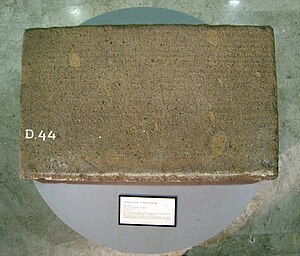Kelurak inscription
| Kelurak inscription | |
|---|---|
 Kelurak inscription, displayed at National Museum of Indonesia, Jakarta | |
| Material | Andesite stone |
| Writing | Pranagari script in Sanskrit |
| Created | 700 Saka (778 CE) |
| Discovered | Lumbung temple in Kelurak village, Klaten Regency, located not far north of Prambanan temple, Central Java, Indonesia |
| Present location | National Museum of Indonesia, Jakarta |
| Registration | D.44 |
The Kelurak inscription is an inscription dated 704 Saka (782 CE), written in Sanskrit with Pranagari script, discovered near Lumbung temple in Kelurak village, located not far north of Prambanan temple, Central Java, Indonesia.
The writings on the inscription was discovered in poor condition with several parts are unclear and unreadable, as the result historians only could translate the main information of the inscription.
Contents
The inscription mentioned about the construction of a sacred buddhist building to house the Manjusri statue that contain the wisdom of Buddha, dharma, and sangha; the same trinity as Brahma, Vishnu and Maheshvara. The construction of this sacred building was ordered by King Indra, revered in his official name Sri Sanggramadhananjaya.[1][2]: 89 The reference to Hindu gods in this Buddhist temple signify the Tantrayana—Vajrayana buddhism influence. The temple dedicated to Manjusri is identified as Sewu temple, located not far north from Prambanan temple.
Today the inscription is displayed in National Museum of Indonesia, Jakarta, under the inventory number No. D.44.
See also
- Canggal inscription (732)
- Kalasan inscription (778)
- Manjusrigrha inscription (792)
- Karangtengah inscription (824)
- Tri Tepusan inscription (842)
References
- ^ Drs. R. Soekmono, (1988) [First printed in 1973]. Pengantar Sejarah Kebudayaan Indonesia 2, 2nd ed. Yogyakarta: Penerbit Kanisius. p. 45.
{{cite book}}: CS1 maint: extra punctuation (link) - ^ Coedès, George (1968). Walter F. Vella (ed.). The Indianized States of Southeast Asia. trans.Susan Brown Cowing. University of Hawaii Press. ISBN 978-0-8248-0368-1.
Further reading
- Miksic, John N (1994-09-01), "Imagine Buddha in Prambanan: Reconsidering the Buddhist Background of the Loro Jonggrang Temple Complex", Journal of Southeast Asian Studies, 25 (2), Cambridge University Press: 442, doi:10.1017/s0022463400013692, ISSN 0022-4634 being a review of - Jordaan, Roy E; Rijksuniversiteit te Leiden. Vakgroep Talen en Culturen van Zuidoost-Azië en Oceanië (1993), Imagine Buddha in Prambanan : reconsidering the Buddhist background of the Loro Jonggrang temple complex, Vakgroep Talen en Culturen van Zuidoost-Azie en Oceanie, Rijksuniversiteit te Leiden, ISBN 978-90-73084-08-7
